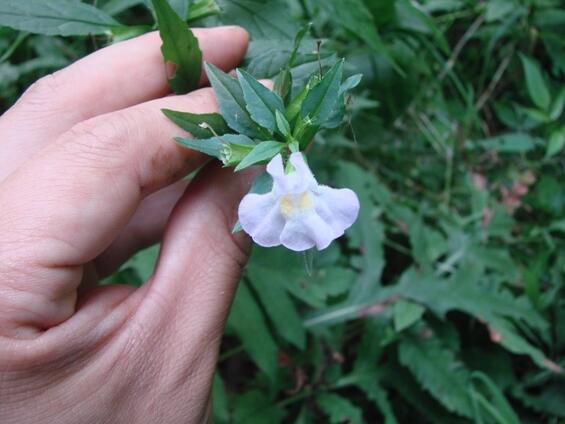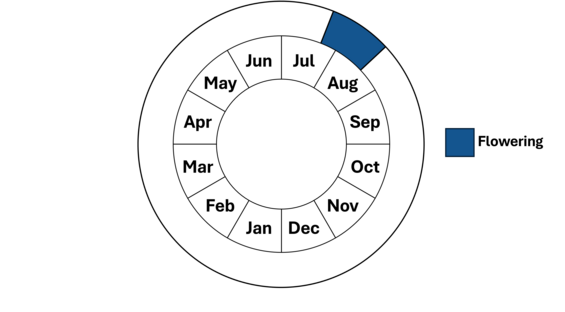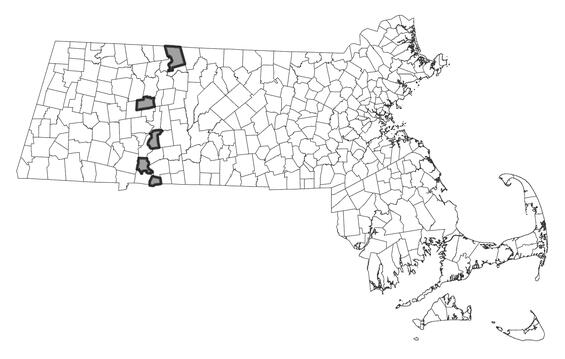- Scientific name: Mimulus alatus
- Species of Greatest Conservation Need (MA State Wildlife Action Plan)
- Endangered (MA Endangered Species Act)
Description
Winged monkey-flower, a member of the figwort family (Scrophulariaceae), is an erect herbaceous perennial, up to 1 m (3.25 ft) high, with pale lavender-blue flowers. Its opposite-toothed leaves are elliptical, lanceolate, or ovate in shape and taper to winged petioles. The hairless stem is square in cross-section and has weakly developed wings (thin, membranous extensions). Winged monkey-flower’s green calyx (outermost floral whorl) is tubular and angled, with triangular lobes ending in bristle-like tips. The 2.5-3.5 cm (1-1.4 in) long corolla is two-lipped, varies from violet-blue to pink, and has a yellow-shaded throat. (Occasionally, flowers may also be white.) The peduncles, or flower stalks, are very short, making the flowers appear almost sessile (stalkless). The flowering season extends from late July to mid-August. Winged monkey-flower’s many minute seeds are contained in a 1 cm (0.4 in) long, ovate-oblong capsule (a type of dry fruit that opens to discharge its seeds).
Winged monkey-flower resembles the common monkey flower (M. ringens). However, common monkey flower has sessile leaves, with leaf margins that are less sharply toothed. Furthermore, the flower stalks of M. ringens are about as long as the flower, while those of winged monkey-flower are very short.

Winged monkey-flower (Mimulus alatus)
Life cycle and behavior
This is a perennial species.

Population status
Winged monkey-flower is currently listed as Endangered in Massachusetts. All species listed under the Massachusetts Endangered Species Act are protected from take (collecting, picking, killing, moving, etc). MassWildlife’s Natural Heritage & Endangered Species Program has 9 records from 3 counties: Franklin, Hampden, and Hampshire. Seven of these records have been observed within the last 25 years. Winged monkey-flower was rediscovered in Massachusetts in 1978, after not being recorded here for over 90 years. There are also two questionable (uncertain identification of the species) historical stations (unverified since 1984). Winged monkey-flower is also considered to be rare in New York, Connecticut, New Jersey, Iowa, Nebraska, and Ontario. It was present historically in Michigan.

Distribution in Massachusetts. 1999-2024. Based on records in the Natural Heritage Database.
Distribution and abundance
Winged monkey-flower has been documented as occurring from Massachusetts to southern Ontario and southern Michigan south to Florida and Texas. A disjunct population occurs in Nebraska.
Habitat
M. alatus grows in floodplain forests on the banks of streams tributary to a major river. These forest habitats are flooded each spring for days or even weeks at a time. Associated species include silver maple (Acer saccharinum), green ash (Fraxinus pennsylvanica), pin oak (Quercus palustris), common monkey-flower (M. ringens), bog hemp (Boehmeria cylindrical), and sensitive fern (Onoclea sensibilis). All six current stations (discovered or relocated since 1984) are found on tributaries of the Connecticut River.
Healthy habitats are vital for supporting native wildlife and plants. Explore habitats and learn about conservation and restoration in Massachusetts.
Threats
Populations of all current stations are small and vulnerable to loss, especially if the annual flooding of their habitats were to be reduced. Limitation of habitat is the major factor in the plant’s rarity in Massachusetts, although climatic and other factors may also be involved.
Conservation
As with most rare species, little is known about winged monkey-flower’s exact habitat needs. The following comments are based primarily on observations of the various populations in Massachusetts. Winged monkey-flower is a floodplain species dependent on annual flooding for its survival. In order to maintain the existing populations and prevents its extirpation from Massachusetts, it is critical that its habitat remain intact and protected against any change of water regimes. Since the species occurs near the months of tributary streams and large rivers, the flooding regime of the major river affects that of the smaller stream, and alterations of the flow of the major river may have a strong effect on the smaller stream; the flows of both streams need to be maintained. As with all herbaceous plants, exotic species can cause problems if they become established near winged monkey-flower. All of the current populations of winged monkey-flower grow below a forest canopy; it is likely that it is a species that required filtered light, rather than full sun, and the nearby trees ought to be left. Grazing has been a problem at one site; removal of the grazers in such cases ought to solve that problem. Other possible changes to the habitat that could cause problems include erosion and siltation.
Contact
| Date published: | May 8, 2025 |
|---|